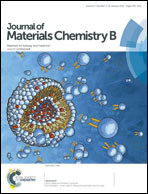Injectable and redox-responsive hydrogel with adaptive degradation rate for bone regeneration†
Abstract
Hydrogel systems with adaptive degradation behavior are of interest for application in tissue regeneration. In the present study, an in situ crosslinkable poly(ethylene glycol) (PEG) hydrogel was developed as an injectable scaffold. The hydrogel formed rapidly via oxidation of thiolated PEG precursors. The phase transition was further proved by injecting in vivo under physiological conditions. The gelation time could be controlled expediently, as well as the storage modulus ranging from 351 Pa to 10.6 kPa. Inversely, disentanglement of the disulfide-bridged network occurred at low concentration of reduced glutathione (GSH) which served as scissors to cleave the disulfide moieties. Degradation time can be modulated from 2 days to 32 days, resulting in corresponding protein release kinetics from 5 days to 32 days. In addition, obvious cell spreading and migration were observed within the gel. Moreover, the osteoinductive growth factor, recombinant human bone morphogenetic protein-2 (rhBMP-2), was loaded into the hydrogel and ectopic bone formation was induced along with gel degradation and release of rhBMP-2. Overall, the obtained results clearly demonstrate a disulfide crosslinked hydrogel with inherent advantages including redox-responsive gelation and degradation, cell ingrowth and tunable release profile, thus it may provide a promising injectable carrier for tissue regeneration in terms of non-invasive and cytokine delivery strategies.


 Please wait while we load your content...
Please wait while we load your content...